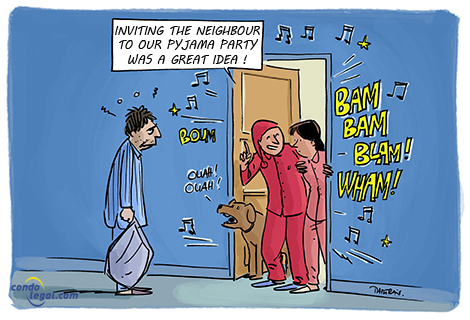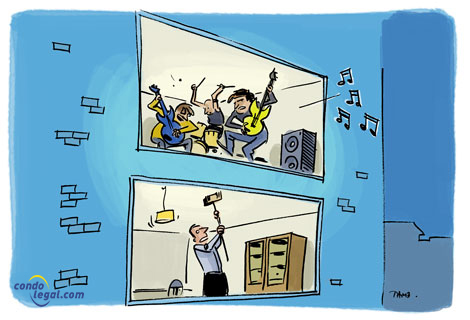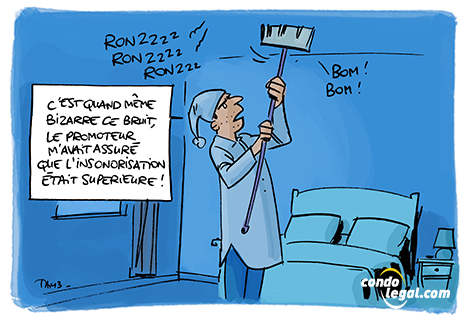 In principle, co-owners have the right to enjoy their private portion as they see fit. This use nevertheless has limits, namely that the right of enjoyment must not exceed normal neighborhood inconveniences. If the nuisance caused by an occupant of the immovable becomes excessive, it constitutes an abnormal neighborhood disturbance. This is the case in the event of non-compliance with clauses relating to the peaceful enjoyment of private portions, stipulated in the by-laws of the immovable. However, an abnormal neighborhood disturbance does not systematically constitute a violation of the declaration of co-ownership, as in some circumstances, this type of nuisance can be sanctioned, even if the perpetrator has not committed any fault.
In principle, co-owners have the right to enjoy their private portion as they see fit. This use nevertheless has limits, namely that the right of enjoyment must not exceed normal neighborhood inconveniences. If the nuisance caused by an occupant of the immovable becomes excessive, it constitutes an abnormal neighborhood disturbance. This is the case in the event of non-compliance with clauses relating to the peaceful enjoyment of private portions, stipulated in the by-laws of the immovable. However, an abnormal neighborhood disturbance does not systematically constitute a violation of the declaration of co-ownership, as in some circumstances, this type of nuisance can be sanctioned, even if the perpetrator has not committed any fault.
Two regimes of liability
The Supreme Court of Canada has recognized in the case of Ciment du Saint-Laurent inc. vs. Barrette, that there are two regimes of liability applicable to an owner. The first is the legal regime of civil liability, based on a fault (article 1457 of the Civil Code of Québec), while the second is a regime of liability without fault, based on the level of the disturbances suffered by the victim (article 976 of the Civil Code of Quebec).
Civil liability regime based on faulty behavior (article 1457 of the Civil Code of Quebec)
This regime is based on a fault, a damage and a causal connection between the two. Civil fault is assessed according to the rules of conduct to be adopted by anyone according to circumstances, such as co-owners who move out or move in at hours prohibited by the declaration of co-ownership, and who in doing so disturb the peaceful enjoyment of occupants. In other words, a fault is committed when the obligation to act reasonably, with prudence and diligence is not respected.
Level of the inconvenience suffered (article 976 of the Civil Code of Quebec)
The level of the inconvenience suffered does not seek to establish a fault, but rather it is based on the consequences attached to the actions undertaken, such as, a co-owner replacing his living room carpet with hard floor covering (e.g. hardwood floor). Even if the declaration of co-ownership allows it, the work reduces the initial acoustic performance of the immovable. Consequently, the neighbor below now clearly hears impact and aerial noises. In the event it causes an abnormal neighborhood disturbance, the liability of the co-owner concerned could be engaged.
Article 976 of the Civil Code of Quebec provides however that "Neighbours shall suffer the normal neighbourhood annoyances that are not beyond the limit of tolerance they owe each other, according to the nature or location of their land or local usage”. However, the law does not specify what is an "abnormal neighborhood disturbance". Consequently, the courts must determine, on a case-by-case basis, whether the inconvenience suffered causes an injury or not (e.g. noise, violent acts and behavioral disorders). This limit of tolerance must therefore be objective, in the sense that it will take into account that the co-owners are contiguous neighbors, that they live in close proximity and share common portions, especially in a immovable where soundproofing meets minimum standards.
Enforcement of the declaration of co-ownership
Article 1063 of the Civil Code of Quebec provides that: “Each co-owner has the disposal of his fraction; he has free use and enjoyment of his private portion and of the common portions, provided he complies with the by-laws of the immovable and does not impair the rights of the other co-owners or the destination of the immovable”. The declaration of co-ownership generally includes provisions aimed at governing, or even prohibiting certain activities or certain behaviors within a co-ownership, in order to avoid the occurrence of abnormal neighborhood disturbances, regardless of the nature of the nuisance: audible, olfactory or visual. For example, an abnormal neighborhood disturbance can sometimes result from the unauthorized replacement of a carpet with a hardwood floor. If this is the case, measures must be taken to enforce the declaration of co-ownership. Whether by a co-owner or the syndicate.
Frequently, offenders do not feel concerned by the declaration of co-ownership. In such cases, the board of directors must ensure that it is respected rigorously. It must communicate with the persons concerned, in writing, to remind them that they have obligations. Typically, this is enough to stop inappropriate behavior.
First steps
Before taking a legal recourse, you can take certain actions to end the abnormal neighborhood disturbances:
If you inform your neighbour of your concern, but he does not stop his inappropriate behavior, you could also:
Going to court
When attempts to settle the dispute amicably have failed, a legal recourse must be undertaken to obtain an order to cease the neighborhood disturbance, as well as damages. This process cannot be initiated if the declaration of co-ownership provides an arbitration clause, the purpose of which is removing a dispute from the jurisdiction of the courts.
Tenant: damages and resiliation of the lease
In the event of abnormal neighborhood disturbances caused by a tenant, any co-owner who suffers damages therefrom can sue the lessor co-owner and his tenant for the damage suffered. After notifying them, the resiliation of the lease may be requested by the syndicate, when the non-compliance with an obligation (in particular those in the by-laws of the immovable) by the lessee causes serious injury to a co-owner, or to another occupant of the immovable.
 WHAT YOU SHOULD KNOW ! Proof of nuisances can be established by various means: emails exchanged with the neighbor causing a nuisance, bailiff's report, testimonies and an expert report (e.g. report on impact or aerial noise established by an acoustician), to name just a few.
WHAT YOU SHOULD KNOW ! Proof of nuisances can be established by various means: emails exchanged with the neighbor causing a nuisance, bailiff's report, testimonies and an expert report (e.g. report on impact or aerial noise established by an acoustician), to name just a few.
 WHAT TO KEEP IN MIND : Abnormal neighborhood disturbances are nuisances which can be sanctioned, even if their author has not committed any fault. It is the abnormality of the nuisance that allows the judge to sanction the disturbance and compensate the victim.
WHAT TO KEEP IN MIND : Abnormal neighborhood disturbances are nuisances which can be sanctioned, even if their author has not committed any fault. It is the abnormality of the nuisance that allows the judge to sanction the disturbance and compensate the victim.
 WARNING ! Any clause of the declaration of co-ownership, the purpose of which is regulating or even prohibiting an activity or behavior likely to cause an abnormal neighborhood disturbance, can only produce its effects if it is justified by the destination of the immovable. Remember that is without effect any decision of the syndicate which, contrary to the declaration of co-ownership, imposes on a co-owner a change in the destination of his private portion or a change in the use he may make of it.
WARNING ! Any clause of the declaration of co-ownership, the purpose of which is regulating or even prohibiting an activity or behavior likely to cause an abnormal neighborhood disturbance, can only produce its effects if it is justified by the destination of the immovable. Remember that is without effect any decision of the syndicate which, contrary to the declaration of co-ownership, imposes on a co-owner a change in the destination of his private portion or a change in the use he may make of it.

.png)




